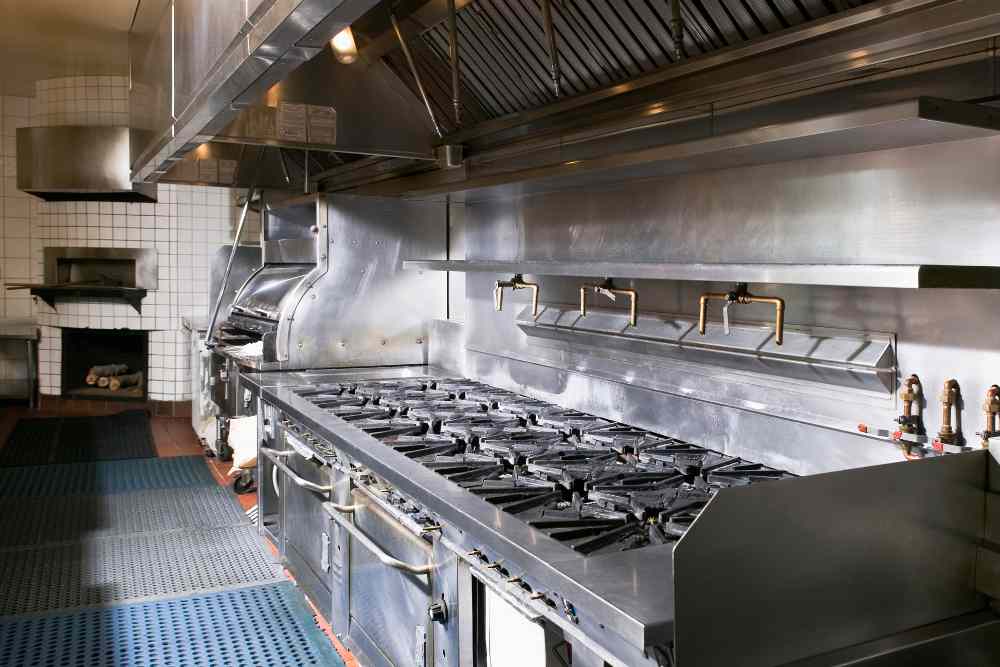How to Diagnose a Clogged Kitchen Exhaust System

How to Diagnose a Clogged Kitchen Exhaust System
Ontario-wide Kitchen Exhaust and Hood Cleaning – Best prices and service guaranteed.
Understanding the Importance of a Clean Kitchen Exhaust System
Before we delve into the diagnostic process, it is essential to understand why a clean kitchen exhaust system is so important. The primary function of a kitchen exhaust system is to remove smoke, odors, and airborne contaminants generated during cooking. By doing so, it helps maintain a comfortable and healthy environment for both the kitchen staff and the customers.
Additionally, a clean kitchen exhaust system plays a crucial role in preventing grease buildup, which can lead to fire hazards. According to the National Fire Protection Association (NFPA), cooking equipment was involved in 61% of all reported home structure fires between 2014 and 2018. Regular maintenance and cleaning of the kitchen exhaust system can significantly reduce the risk of such incidents.
Signs and Symptoms of a Clogged Kitchen Exhaust System
Now that we understand the importance of a clean kitchen exhaust system, let’s explore the signs and symptoms that indicate a clogged system:
Ontario-wide Kitchen Exhaust and Hood Cleaning – Best prices and service guaranteed.
- Excessive Smoke: If you notice an excessive amount of smoke lingering in your kitchen, even when using proper cooking techniques, it could be a sign of a clogged exhaust system. The buildup of grease and other debris in the system restricts the airflow, leading to poor smoke extraction.
- Unpleasant Odors: A properly functioning kitchen exhaust system should effectively remove cooking odors. If you notice persistent and unpleasant odors in your kitchen, it may indicate a clogged system that is unable to eliminate these odors efficiently.
- Grease Buildup: Take a look at the exhaust hood and the surrounding areas. If you notice a significant amount of grease buildup, it is a clear indication that your exhaust system is not functioning optimally. Grease buildup not only affects the system’s efficiency but also poses a significant fire hazard.
- Reduced Airflow: A clogged exhaust system will have reduced airflow, which can be observed by weak suction at the exhaust hood. You may also notice that the smoke and steam generated during cooking are not being adequately extracted.
- Increased Energy Consumption: A clogged kitchen exhaust system requires more energy to operate efficiently. If you notice a sudden increase in your energy bills without any other apparent cause, it could be due to a clogged system that is working harder to compensate for the reduced airflow.
Ontario-wide Kitchen Exhaust and Hood Cleaning – Best prices and service guaranteed.
Diagnosing a Clogged Kitchen Exhaust System
Now that we have identified the signs and symptoms of a clogged kitchen exhaust system, let’s discuss the diagnostic process:
1. Visual Inspection
The first step in diagnosing a clogged kitchen exhaust system is to visually inspect the various components. Start by examining the exhaust hood and the surrounding areas for any visible signs of grease buildup. Check the exhaust fan blades for dirt and debris. Additionally, inspect the ductwork for any obstructions or blockages.
2. Airflow Test
To determine the airflow of your kitchen exhaust system, you can perform a simple test using a smoke pencil or a piece of tissue paper. Hold the smoke pencil or tissue paper near the exhaust hood and observe the direction of the smoke or the movement of the paper. If the smoke is not being drawn into the hood or the paper is not moving, it indicates a restricted airflow, possibly due to a clog.
Ontario-wide Kitchen Exhaust and Hood Cleaning – Best prices and service guaranteed.
3. Grease Filter Inspection
The grease filters in your kitchen exhaust system play a vital role in trapping grease and other debris. Over time, these filters can become clogged and require cleaning or replacement. Remove the grease filters and inspect them for any signs of heavy grease buildup. If the filters are excessively dirty or damaged, it is a clear indication that your exhaust system is not functioning optimally.
4. Professional Inspection
If you are unable to identify the cause of the clog or if you suspect a more severe issue, it is advisable to seek professional help. A certified kitchen exhaust system technician will have the expertise and specialized tools to conduct a thorough inspection and diagnose any underlying problems.
Addressing a Clogged Kitchen Exhaust System
Once you have diagnosed a clogged kitchen exhaust system, it is crucial to address the issue promptly to ensure the system’s optimal performance and safety. Here are some steps you can take:
Ontario-wide Kitchen Exhaust and Hood Cleaning – Best prices and service guaranteed.
1. Cleaning the Exhaust Hood and Ductwork
Start by cleaning the exhaust hood and the surrounding areas. Remove any grease buildup using a degreaser and a scrub brush. Pay close attention to the exhaust fan blades and ensure they are free from dirt and debris. Next, clean the ductwork using a specialized duct cleaning brush or hire a professional duct cleaning service.
2. Cleaning or Replacing Grease Filters
If the grease filters are reusable, clean them thoroughly using warm soapy water or a degreaser. Allow them to dry completely before reinstalling. If the filters are damaged or excessively dirty, it is advisable to replace them with new ones to ensure optimal performance.
3. Regular Maintenance
Prevention is always better than cure. Implementing a regular maintenance schedule for your kitchen exhaust system can help prevent clogs and ensure its long-term efficiency. Regularly clean the exhaust hood, grease filters, and ductwork. Additionally, schedule professional inspections and cleanings at least once a year.
Ontario-wide Kitchen Exhaust and Hood Cleaning – Best prices and service guaranteed.
A clogged kitchen exhaust system can lead to reduced efficiency, unpleasant odors, and even fire hazards. By understanding the signs and symptoms of a clogged system and following the diagnostic process outlined in this article, you can effectively identify and address the issue. Regular maintenance and cleaning, along with professional inspections, are essential for maintaining a clean and healthy kitchen environment. By taking proactive measures, you can ensure the optimal performance and safety of your kitchen exhaust system.
Learn more about “Signs You Need to Clean your Kitchen Exhaust System” here.
Frequently asked questions about How to Diagnose a Clogged Kitchen Exhaust System

What are the common symptoms of a clogged kitchen exhaust system? 🧐
Diagnosing a clogged kitchen exhaust system starts with observing several telltale signs:
Reduced Airflow 💨: The most noticeable symptom. If the kitchen remains smokey or the steam doesn’t clear as quickly, there might be an obstruction.
Grease Build-up 🍳: If there’s an excessive amount of grease or residue on the hood or filters, clogging is likely.
Unusual Sounds 🎧: A straining or louder exhaust fan can indicate it’s working harder due to blockages.
Persistent Odors 👃: Smells lingering post-cooking can be a sign that the exhaust isn’t venting effectively. Identifying these early symptoms can be crucial for timely intervention. 🔍✨
How can I check the airflow of my kitchen exhaust to see if it’s clogged? 🤔
An easy and effective method is the “paper test.” Hold a piece of paper or tissue to the exhaust vent while it’s turned on. If the system is functioning well, the paper should be held up by the airflow 📃💨. If it falls or barely sticks, it’s a sign of reduced airflow and potential clogging. Remember, this is a preliminary test. If you suspect a problem, consider a thorough inspection or consulting a professional. 🛠️👷
Are there any DIY methods to diagnose deeper clogs in the exhaust system? 🛠️
For deeper diagnostics, you can:
Visual Inspection 👀: Turn off the system, safely remove the exhaust filters, and use a flashlight to inspect for noticeable blockages or excessive grease build-up.
Smoke Test 🔥: Safely introduce a small amount of smoke (using a smoke pencil or incense stick) near the exhaust intake. If the smoke doesn’t get drawn up or disperses unevenly, there might be a blockage.
Listen Carefully 🎧: Turn the fan on and off, listening for any unusual sounds or delays in starting. However, while DIY methods can be insightful, nothing beats a professional’s expertise when dealing with complex exhaust systems. Safety first! ☝️🔧
Does a faulty exhaust fan always indicate a clogged system? ⚙️
Not necessarily. While a straining or malfunctioning exhaust fan can be a sign of clogging, it can also be indicative of electrical issues, worn-out parts, or motor problems 🌀🔌. If the fan isn’t working as expected, it’s crucial to diagnose the root cause – be it clogging, electrical issues, or something else. Sometimes, it’s a combination of factors! When in doubt, get a professional’s opinion. 🤝💡
How often should I inspect my kitchen exhaust system to prevent severe clogs? 🗓️
Regular checks are the key to a well-maintained exhaust system. For high-volume kitchens, a monthly inspection is ideal. For home kitchens or places with lighter cooking, a quarterly check should suffice. Remember, these are general guidelines. If you cook greasy foods frequently or notice any of the symptoms mentioned above, more frequent checks might be in order. Proactive care is always better than reactive repairs! 🛎️🌟
Regular diagnostics and timely interventions can keep your kitchen exhaust system running smoothly and safely. If you ever have more questions or need further guidance, always feel free to reach out. Safe cooking and clear venting to you! 😊👩🍳
- hood cleaning
- How to Diagnose a Clogged Kitchen Exhaust System
- kitchen exhaust cleaning
- restaurant hood cleaning






